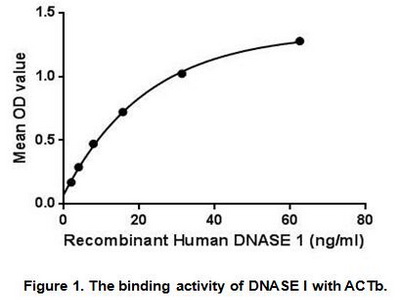Active Deoxyribonuclease I (DNASE1)
DNaseI; DNL1; DRNI; DNase-I; Dornase alfa
- Product No.APB127Hu01
- Organism SpeciesHomo sapiens (Human) Same name, Different species.
- Buffer FormulationPBS, pH7.4, containing 0.01% SKL, 5% Trehalose.
- TraitsFreeze-dried powder
- Purity> 90%
- Isoelectric Point5.0
- ApplicationsCell culture; Activity Assays.
- Download Instruction Manual
- UOM 10µg50µg 200µg 1mg 5mg
-
FOB
US$ 202
For more details, please contact local distributors!US$ 504
For more details, please contact local distributors! US$ 1008
For more details, please contact local distributors! US$ 3024
For more details, please contact local distributors! US$ 7560
For more details, please contact local distributors!
ACTIVITY TEST of the Active Deoxyribonuclease I (DNASE1)

Deoxyribonuclease I (usually called DNase I) is a nonspecific endonuclease that cleaves DNA preferentially at phosphodiester linkages adjacent to a pyrimidine nucleotide, yielding 5'-phosphate-terminated polynucleotides with a free hydroxyl group on position 3', on average producing tetranucleotides. It acts on single-stranded DNA, double-stranded DNA, and chromatin. DNase I can be activated by bivalent metals such as Mg2 and Ca2 . This endonuclease enzyme is common reagents used in biochemical methods requiring diestion of DNA and recovery of RNA, or where DNA is to be removed without affecting structural proteins or enzymes. For example, DNase I is frequently used to remove template DNA following in vitro transcription, and to remove contaminating DNA in total RNA preparations (especially those from transfected cells that may contain plasmid DNA), used for ribonuclease protection assays, cDNA library contraction, and RT-PCR. Besides, Actin Beta (ACTb) has been identified as an interactor of DNase I, thus a binding ELISA assay was conducted to detect the interaction of recombinant human DNase I and recombinant human ACTb. Briefly, DNase I were diluted serially in PBS, with 0.01% BSA (pH 7.4). Duplicate samples of 100uL were then transferred to ACTb-coated microtiter wells and incubated for 2h at 37℃. Wells were washed with PBST and incubated for 1h with anti-DNase I pAb, then aspirated and washed 3 times. After incubation with HRP labelled secondary antibody, wells were aspirated and washed 3 times. With the addition of substrate solution, wells were incubated 15-25 minutes at 37℃. Finally, add 50µL stop solution to the wells and read at 450nm immediately. The binding activity of of DNase I and ACTb was shown in Figure 1, and this effect was in a dose dependent manner.
USAGE of the Active Deoxyribonuclease I (DNASE1)
Reconstitute in 10mM PBS (pH7.4) to a concentration of 0.1-1.0 mg/mL. Do not vortex.
STORAGE of the Active Deoxyribonuclease I (DNASE1)
Avoid repeated freeze/thaw cycles. Store at 2-8°C for one month. Aliquot and store at -80°C for 12 months.
STABILITY of the Active Deoxyribonuclease I (DNASE1)
The thermal stability is described by the loss rate. The loss rate was determined by accelerated thermal degradation test, that is, incubate the protein at 37°C for 48h, and no obvious degradation and precipitation were observed. The loss rate is less than 5% within the expiration date under appropriate storage condition.
INCREMENT SERVICES
BCA Protein Quantification Kit
Molecular Mass Marker for Protein
Monoclonal Antibody Customized Service
Polyclonal Antibody Customized Service
Protein Activity Test Experiment Service
Electrophoretic Mobility Shift Assay (EMSA) Experiment Service
Buffer
Lentivirus Packaging Experiment Service
Adenovirus Packaging Experiment Service
Real Time PCR Experimental Service
Spike RBD Protein (S-RBD)
Protein G
Protein A

